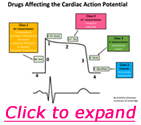 Medications
MedicationsChildren who have brief or infrequent bouts of SVT may not need treatment but should receive regular supervision (Mayo Clinic, 2019).
Treatment of a child with PSVT will depend on a number of factors which include:
Initial at home approaches
Contraindicated
Eyeball compression is contraindicated in children because of the risk of eyeball-retina damage.
According to Neroni et al (2014), these are the recommended medications:
Not recommended for children
Verapamil – risk of electromechanical dissociation
Instant Feedback:
The longer an episode of PSVT occurs, the more difficult it can be to convert.
Ablation therapy
Ablation therapy is usually reserved for patients who do not respond to anti- arrhythmic treatment and are in heart failure.
Cardiac ablation works by destroying abnormal fiber in the heart that triggers or perpetuates tachycardia. This prevents abnormal electrical signals from creating arrhythmia.
This is a description of a typical ablation procedure:
The ablation studies have a higher risk below the age of 5. Physicians typically will only carry out this procedure in childre under 5 who are extremely ill. By the age of 5 there is little risk for the child. The Mayo Clinic reports a 95% to 98% success rate with a less than 1% complication rate with a two day recovery. Usual this procedure results in a permanent cure. https://www.mayoclinic.org/medical-professionals/cardiovascular-diseases/news/managing-pediatric-supraventricular-tachycardia/mac-20474690 ![]()
Outlook
The outlook for children with SVT is excellent. The problem is usually not life- threatening plus the current treatments are highly effective. Successful ablation procedures lead to a cure. With no increased incidence of long term effents. https://www.mayoclinic.org/medical-professionals/cardiovascular-diseases/news/managing-pediatric-supraventricular-tachycardia/mac-20474690 ![]()
Dubin, A.M. et al. (2019). Pediatric and congenital electrophysiology society initiative on device needs in pediatric electrophysiology. Heart Rhythm 16:493.
https://www.mayoclinic.org/medical-professionals/cardiovascular-diseases/news/managing-pediatric-supraventricular-tachycardia/mac-20474690
Fanos, V., Mussap, M., Faa, G. & Papageorgiou, A. (2015). Paroxysmal supraventricular tachycardia: physiopathology and management. Proceedings of the 10th International Workshop on Neonatology. https://worldwidescience.org/topicpages/s/supraventricular+tachycardia+vagal.html.
Mayo Clinic, 2019 https://www.mayoclinic.org/medical-professionals/cardiovascular-diseases/news/managing-pediatric-supraventricular-tachycardia/mac-20474690.
Neroni, P., Ottonello, G., Manus, D., Atzei, A., Trudu, E., Floris, S. & Fanos, V. (2014). Paroxysmal supraventricular tachycardia: physiopathology and management. J Pediatr Neonat Individual Med. 3(2). e030243. doi: 10.7363/030243.
Saul, J.P. et al. (2016). PACES/HRS expert consensus statement on the use of catheter ablation in children and patients with congenital heart disease. Heart Rhythm 13:e251.
© RnCeus.com